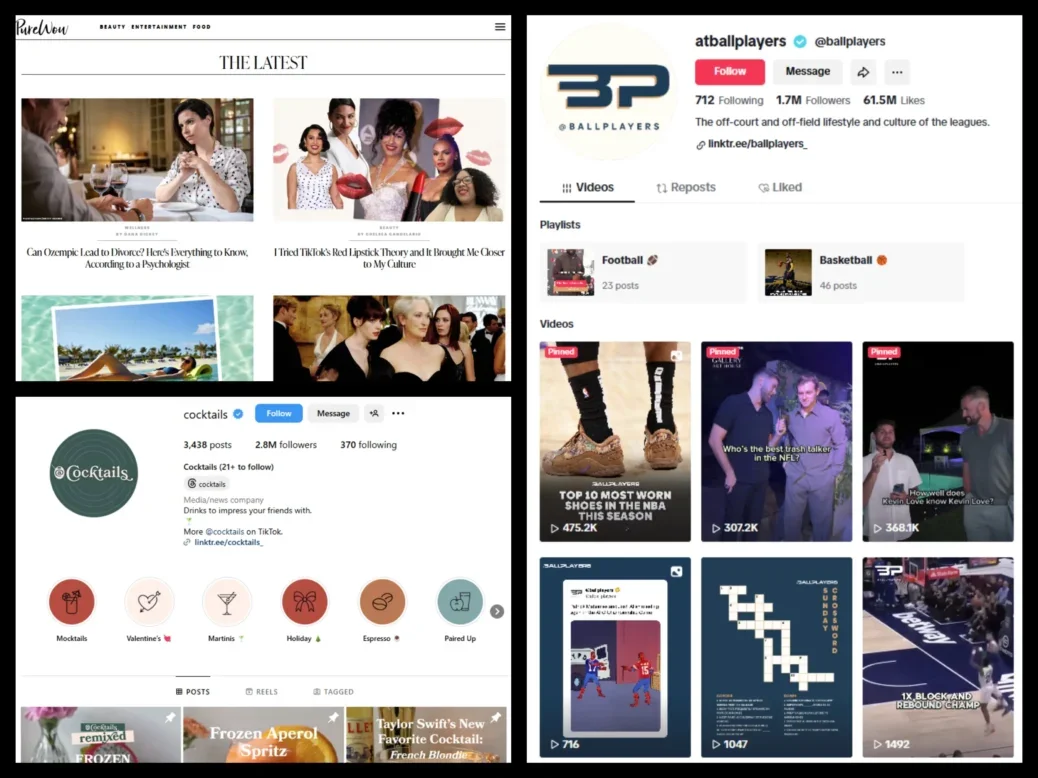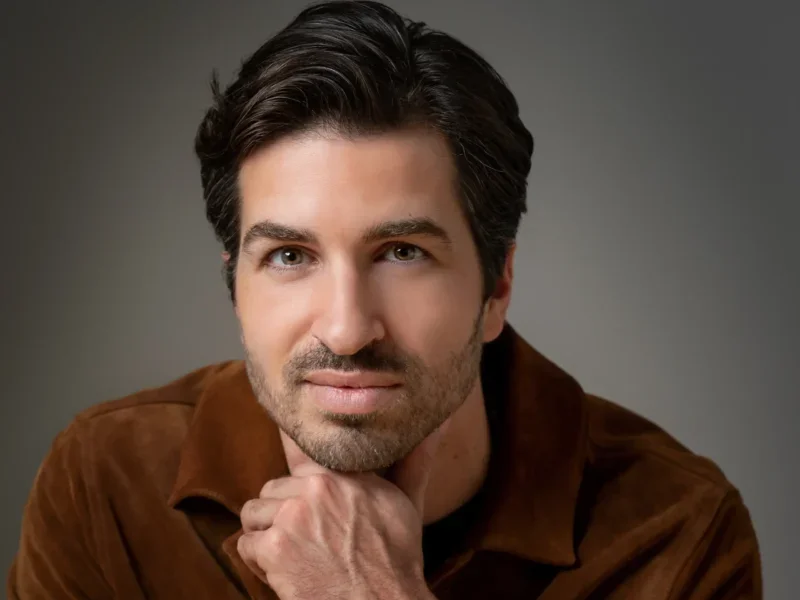
The chief revenue officer of profitable US publisher Gallery Media Group believes it has found the difference between publishers merely being “really good” on Tiktok and Instagram and actually building brands there.
Gallery Media Group (GMG) owns women’s media title PureWow, which has its own website, and more than 50 social-only brands across short-form video platforms Tiktok, Instagram and Youtube Shorts including @moms, @cocktails and @recipes. In total it claims to reach more than 200 million consumers.
GMG has been profitable since 2011 and made $50m revenue in 2024 – predominantly from advertising, followed by affiliate/e-commerce. This year is again expected to be a growth year.
Chief revenue officer Chris Anthony told Press Gazette the business has found success in working with major brands to create direct monetisation opportunities rather than relying on the varying revenue share deals offered by the different platforms.
PureWow was launched 15 years ago by Ryan Harwood, now GMG chief executive. Anthony claimed it is now “bigger than all the women’s lifestyle brands in the space”.
Harwood sold the business to entrepreneur Gary Vaynerchuk in January 2017 meaning it is now part of VaynerX. Anthony said the sale “gave us the permission to think about other areas of the business we wanted to be in and think about how to evolve to be a wider portfolio business”, leading them to build brands on social platforms.
One of GMG’s biggest brands is @ballplayers, focused on the off-court and off-field lifestyle and culture of WNBA, NBA and NFL players. It has 1.7 million followers on Tiktok, 1.4 million on Instagram and 479,000 subscribers on Youtube. Another of its major brands, @cocktails, has 2.8 million on Instagram and 2.7 million on Tiktok.
Anthony said they are treated “like a media brand but all living on social-first platforms” and that the business is “obsessed with that short-form video behaviour”.
He argued GMG’s successes are different to a publisher saying “we’re really good” on various social platforms: “We’ve built brands there. We’ve built brands that are natively built in Instagram, natively built in Tiktok, in Youtube Shorts.”
He said many publishers have used their social accounts “as just a distribution platform and not actually as a platform for content creation” and are still too focused on driving traffic back to their websites.
In previous years, he said, “we were able to use Facebook to do that, but we know that there’s a reason why a lot of these platforms are keeping people engaged there. You have to understand how to build the right experiences there, you have to obsess over what are the features on the platform? How are the algorithms serving up the content? What are the certain features and cultural trends, and how do you land on those to create content?
“So it’s a very nuanced strategy and I think we love the buzzword in our industry of art and science, but I think in social 1,000% you have to be a bit of both.”
The Reuters Institute for the Study of Journalism last month noted that publishers plan to increase investment in short-form video platforms in 2025 but that “video does not come naturally to many print-based newsrooms and short-form video remains hard to monetise, with little opportunity to drive traffic back to websites or apps”.
‘These aren’t just accounts – these are real media brands’
GMG’s social accounts are primarily monetised through advertising brand partnerships: creating sponsored videos to go out on the accounts alongside editorial content or distributing major brands’ assets within the portfolio.
Anthony said there is an “easier, more digestible” story to tell advertisers about PureWow, using industry data like Comscore to show how it stacks up with competitors.
But with the social-first brands, he continued, it is about “getting the marketplace – and I think we’re there now – to understand that those brands on social are as powerful as the web 2.0 brands.
“The amount of consumer attention that people are spending on their For You page, spending on their feed, the amount of time they’re spending with their favourite creator – that’s where the content and the consumer intention is happening.
“So I think that the old legacy publisher brands that amplify their content on Instagram and Tiktok is great, but I think being able to really understand that audience and really be there and understand from a practitioner standpoint has resonated with clients.”

Anthony said this has given GMG an advantage: “I think if you’re looking at Ballplayers against an ESPN or a Bleacher Report, you understand that Ballplayers has this creator mindset. They understand how to create content for that consumer today, whether that be Gen Z, Gen Alpha, young millennials through that sports lens of how people want to consume content.
“So I think the marketplace is finally understanding that these aren’t just accounts. They’re real media brands.”
In addition Anthony said that since GMG is “so close to the consumer in those platforms, it just gives us so many insights to be able to build programmes and partnerships for clients externally, and it also gives incredible insights for our internal team of how do you actually reverse engineer our .com brands to be more responsive to what’s happening in culture?”
These insights also mean GMG is able to use its “social-first sensibility” to do service work for brands, including running Fortune 500 brands’ Tiktok accounts for them.
Anthony also suggested publishers can be too slow to jump on trends because they would wait to write about them or take their time to figure it out. “When you’re building these brands that can play on social, you’re part of it, right? You’re either helping make that cultural moment, or you’re so close to it.
“We’ve done a lot of work. We’ve brought these types of opportunities to brands and said, like, ‘hey, this is exploding on social right now. Here’s the opportunity to inject yourself into it’ and giving them this opportunity to be able to be very quick and agile about it.”
‘Entrepreneurial spirit’ keeps GMG agile
As well as this social practitionership, Anthony said GMG’s “entrepreneurial spirit” is the other major thing that has helped it stay profitable for 13 years amid a difficult digital media environment that has seen the end of brands like Buzzfeed News and Vice.com (although the latter has resumed publishing).
GMG employs around 200 people in the US, a number that Anthony said has allowed it to stay agile. He noted that consolidation across the media industry could be painted as a positive for advertisers but “with that comes with slowness.
“I think that sometimes the larger you get, the more complicated the business model becomes, you lose innovation. I think that we have been able to keep this entrepreneurial spirit and constantly learn, constantly pivot as fast as the industry, and even more importantly, as fast as the consumer does.”
The changing culture around social video has helped as well, Anthony noted: highly-produced video “doesn’t work for the consumer anymore” meaning there is no need to assemble photographers and videographers for a shoot like they might have done five to ten years ago.
Instead, videos being prioritised tend to utilise simple platform features like the “green screen” effect on Tiktok of a person speaking with an article or image behind them.
Some media experts have argued publishers have lost control of the reader relationship by relying too much on the platforms.
But Anthony said a focus on short-form video rather than any particular platform can help. Speaking shortly after the short-lived Tiktok ban in the US, he said: “We think that behaviour is here to stay forever, that if Tiktok got shut down tomorrow, that consumer attention would move to another platform, but it would be very much still steeped in short-form video. And that’s really what we look for – we look for consumer behaviours.
“I think the platforms will constantly make changes, but it’s really about how we can move quickly and adapt those changes. And again, I think making changes when you’re a true practitioner of the platform is very different when it’s just this peripheral part of your business.”
Similarly media consultant Matthew Scott Goldstein urged publishers: “Don’t wait for trends to solidify, be a trendsetter,” noting that even if Tiktok is banned in the US user behaviour around short-form video will continue on other platforms.
E-commerce, experiential and influencer marketing
As well as direct partnerships, GMG has a “significant” e-commerce revenue strategy. On PureWow this is through affiliate links on the website and in emails, while on social it’s through the Tiktok Shop and Instagram Stories. Anthony added that increased livestream shopping behaviour is also expected to “open up a whole new arena from an affiliate standpoint”.
In events, GMG launched an experiential (a more immersive type for brands to be involved with) strand in 2023 called Gallery Houses which have so far appeared at events like Coachella, F1 Miami and the Super Bowl.
Anthony said that “for a while, we were doing events that were very much responsive to what an advertiser wanted to do or what we wanted to do in a moment in time” and that experiential can be hard for brands to justify the return on investment.
But they wanted to “re-engineer” it: “It’s a space that we love, but it’s a space that we need to work harder for marketers, especially when the fragmentation of dollars is constantly happening – brands need to be more stringent and conservative about how they spend, but they want to also still do cool stuff.”
The idea behind Gallery Houses is to “treat them almost like a production shoot” and leverage them as a backdrop for creating content so brands can get the “social payload of being around a big cultural moment but able to walk away with an extreme amount of content that can fuel other needs of the business outside that event”.
“There’s a lot of consumer attention but people don’t have enough content to be able to put out there. So this is a gap we’ve been able to fill for brands and has just been extremely successful of us being able to really bring together cultural moments that matter while solving a business challenge for brands.”
GMG also has an influencer marketing business through which it sources influencers with the right demographic and audience to work with brand campaigns. Anthony said this is “massively growing” in revenue.
Email pged@pressgazette.co.uk to point out mistakes, provide story tips or send in a letter for publication on our "Letters Page" blog
